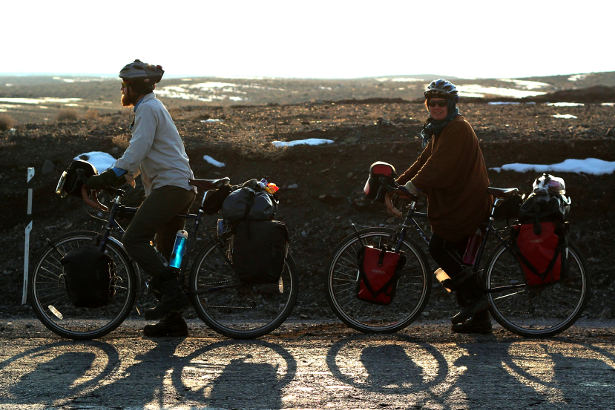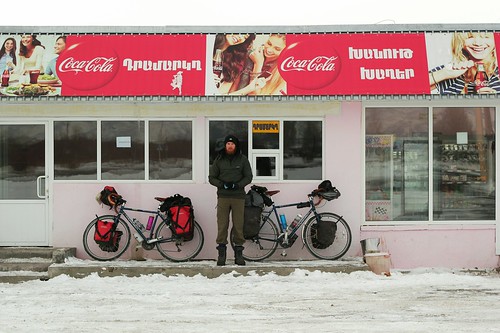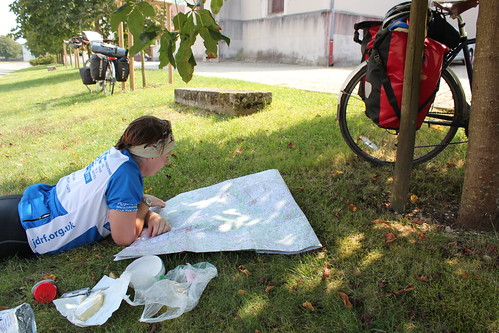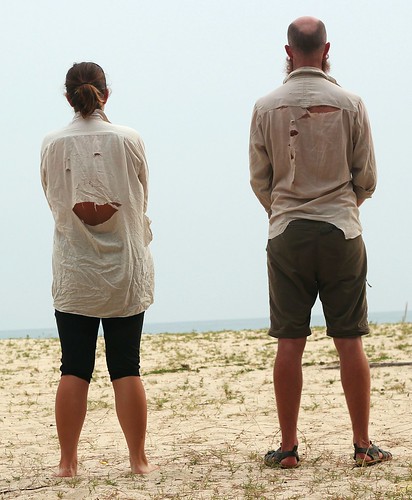
Cycling 10,000 miles from England to Australia took us through a European summer, winter in the Caucasus, a hot India, spring in Korea and Japan, summer in South East Asia and a cold, wet Australia. We still have New Zealand and America to get across but, by now, we have a fairly good idea of what kit works where.
This article details what we wore in different conditions as we cycled around the world.
The temperatures we cycled and camped in ranged from +40 to -20°C (0 – 100°F).
In Eastern Turkey, Armenia and Iran dropped to around -15 or -20°C at their lowest (~0°F). Most of the time it was around 0 to -5°C (~25°F). This lasted for three months.
The three or four combined months in the Middle East, India and South East Asia were often around 30 to 40°C (up to 100°F).
Planning kit for the trip was one of the things we spent the most time on because we knew that expeditions in the cold are miserable without the right stuff. Prior to this trip I have researched, organised and supported many cold weather expeditions to Svalbard, Greenland and Antarctica and spent a little time skiing and camping at -15°C and below so used this experience to inform our kit choices for the winter.
(We’ve written elsewhere about our wet weather gear and the electronics we carried).
[divide]
Tim – Cycling in Warm Weather
Shorts from lightweight zip-off trekking trousers (no underwear) and a long sleeved cotton shirt. Shirt sleeves down, top button fastened and collar up for sun protection or the opposite to keep cool.
Compared to tight-fitting, synthetic cycling clothes, this outfit looks more “normal”, which is good for travelling, and smells less.
On my feet I wore thin hiking socks and SPD cycling shoes or hybrid sandals. Being clipped in ensures a good position on the pedals and gives extra strength without the fear of feet slipping off. However, cycling unclipped makes getting on and off the bikes easier (e.g. jumping off when the bike skids or you get attacked by dogs).
I had fingerless cycling gloves as well as merino liners and Sealskinz waterproof gloves for the cold/weight. The waterproof gloves weren’t great and I’d recommend cheap Goretex mitts like Laura’s instead.
[divide]
Tim – Evenings in Warm Weather
Hiking trousers with the legs attached, thick hiking socks and a long sleeved bamboo base layer. On colder nights I would also wear bamboo leggings, a fleece and a synthetic Primaloft belay jacket.
For rest days and/or when doing the washing, I had a tiny merino t-shirt and a pair of running shorts (which doubled as swimming shorts and pyjamas when staying at peoples’ houses).
[divide]
Tim – Cycling in Cold Weather
Legs: Lycra shorts, bamboo leggings and trekking trousers with a small piece of fleece stuff down my shorts, known as the “Penis Protector” (it was actually the mouth piece from a Buffalo jacket, though never used as such again). This combination worked well and was easily adjusted depending on how cold it was.
Feet: bamboo hiking socks, Sealskinz waterproof socks and thick fleece lined winter boots picked up cheap from Costco. We sent our SPD shoes home for winter. Our feet still got cold on long descents or when setting off but getting off the bikes to push warmed them quickly.
On top: a long sleeve bamboo base layer with either a thin windproof Pertex top for milder weather and ascents, or a Buffalo jacket when colder.
Hands: thumb loops on the bamboo top, merino liner gloves and furry Buffalo mittens most of the time. For cold descents, an XXL pair of fleece lined Sealskinz waterproof winter mittens to go over the top.
Head: a fleece headband to keep my forehead and ears warm whilst avoiding overheating, supplemented with a thin merino hat.
Buffalo and down jackets used to keep warm at stops.
[divide]
Tim – Evenings in Cold Weather
Once stopped for the evening I changed into my head-to-toe woolly merino outfit: thick socks, leggings, long sleeve top and thick balaclava. Over the top were a pair of fleece trousers and fleece top then the same layers as before (Primaloft, Buffalo and down jacket) and a pair of fleece booties in the tent.
It was very rare that I needed all three big warm jackets, especially since we were so often invited into people’s homes in Turkey and Iran. If I did it again I’d probably ditch the down jacket and risk the occasional cool evening or just get into my sleeping bag sooner.
[divide]
Laura – Cycling in Warm Weather
The short answer is leggings with a long shirt.
Legs: three quarter length lycra leggings most of the time (shorts in less conservative Europe). No padding – a Brooks saddle means sores are a rarity (hot humid weather is the only time I get them). I tried wearing normal shorts but find anything with seams can lead to chafe or pain in sensitive areas – for the same reason I don’t bother with underwear. As leggings are currently fashionable across the whole world, I haven’t felt too out of place, especially as I try and wear longer tops to cover my bum (vital at the moment as the lycra leggings are starting to wear thin).
On top: for the first few weeks, I wore a proper cycling jersey as it was branded with JDRF, the charity we’re supporting on this trip (please donate!). Since then I’ve worn a long cotton shirt of the type worn by men in India and Pakistan (I bought it in India). This eventually fell apart so I bought a new shirt in Australia from a cheap clothes shop – I looked at ‘technical’ ones in outdoors shops but couldn’t justify the expense. I chose a man’s shirt each time as they tend to be longer and baggier, important for bum-covering. I wear a Shock Absorber sports bra.
Hands: I wear Sealskinz fingerless cycling gloves (not necessarily the best out there). In rain, I put a pair of very cheap waterproof mitts over the top, which I bought for a fiver from an ex-army store.
[divide]
Laura – Evenings in Warm Weather
The short answer is long trousers and a top.
I change into non-sweaty clothes completely as soon as we stop for the night, including my bra. Otherwise, I get cold quickly. I usually wear Berghaus zip-off trousers, although in SE Asia, where it was very humid, I bought some mega-cheap loose cotton trousers for £1 which were much cooler to wear. I always wear long trousers because mosquitoes love me.
On top, I wear either a linen shirt from Marks and Spencers (doubles as my ‘smart’ top) or a long-sleeved bamboo top, depending on climate.
If it’s cold, I add a Berghaus microfleece and/or my Rab primaloft smock (which I love).
[divide]
Laura – Cycling in Cold Weather
The short answer is long leggings and a long sleeved bamboo top with a Montane windstopper smock. On the coldest days, I cycled in a Buffalo jacket too.
Legs: I used Ronhill leggings (the type with a band that goes under the foot) during winter, as they’re thicker than other leggings and I love them. On very cold days, I wore bamboo leggings underneath them.
On top: I wore my Trekmates bamboo top and a Montane windstopper jacket. The latter provide awesome warmth for the weight and are probably my favourite piece of kit for both cycling and hiking, especially as they don’t cost the earth.
On very cold days, I would cycle in my Buffalo smock. I never thought it would happen as they are so warm but they were perfect, especially as they have excellent venting for when you’re going uphill.
Head: I also wore a Windstopper headband, with another headband too if it’s very cold (like a Buff, but a much cheaper unbranded version which is just as good). I used a fleecy band round my neck which helps keep the wind out.
Hands: Buffalo mitts. On very cold days, Sealskinz winter cycling mitts.
In rain: I wear Berghaus waterproofs on the top and bottom. I did have Sealskinz waterproof socks but lost one somewhere in Iran so now just get wet feet.
[divide]
Laura – Evenings in Cold Weather
The short answer is all my clothes.
On the bottom, it would be leggings (not the ones I cycled in) and Berghaus zip off trousers with at least one pair of thick (Smartwool) socks. On the top, it would be a merino top, thin fleece, Rab primaloft and my Buffalo smock or lightweight down jacket.
I used merino leggings and top but don’t particularly like merino as it makes me itch, even the superfine stuff.
[divide]
There are over 100 cycle tourers’ kit lists available to browse on the Database of Long Distance Cycle Journeys…



What do you think? Please do add your thoughts below…